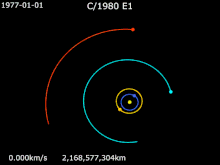astro.wikisort.org - Comet
C/1980 E1 is a non-periodic comet discovered by Edward L. G. Bowell on 11 February 1980 and which came closest to the Sun (perihelion) in March 1982. It is leaving the Solar System on a hyperbolic trajectory due to a close approach to Jupiter. In the 42 years since its discovery only two objects with higher eccentricities have been identified, 1I/ʻOumuamua (1.2) and 2I/Borisov (3.35) .[3][4]
 Hyperbolic path with annual motion | |
| Discovery | |
|---|---|
| Discovered by | Edward L. G. Bowell |
| Discovery date | 11 February 1980 |
| Alternative designations | C/1980 E1 |
| Orbital characteristics A | |
| Epoch | JD 2444972.5 (3 January 1982) |
| Observation arc | 6.88 years |
| Aphelion | ~75000 AU (inbound)[1] |
| Perihelion | 3.3639 AU[2] |
| Eccentricity | 1.057[2] (hyperbolic trajectory) 1.053 (epoch 1984+)[1] |
| Orbital period | ~7.1 million years (epoch 1950)[1] Ejection (epoch 1977+)[1] |
| Inclination | 1.6617° |
| Last perihelion | 12 March 1982[2] |
Overview
Before entering the inner Solar System for a 1982 perihelion passage, C/1980 E1 had a barycentric (epoch 1950-Jan-01) orbit with an aphelion of 75,000 AU (1.2 ly), and a period of approximately 7.1 million years.[1]
As the comet was approaching on 9 December 1980, it passed within 0.228 AU of Jupiter,[5] which accelerated the comet briefly giving an (epoch 1981-Jan-09) eccentricity of 1.066.[1] The comet came to perihelion on 12 March 1982,[2] when it had a velocity of 23.3 km/s (52,000 mph) with respect to the Sun. Since the epoch of 1977-Mar-04, C/1980 E1 has had a barycentric eccentricity greater than 1,[1] keeping it on a hyperbolic trajectory that will eject it from the Solar System. Objects in hyperbolic orbits have a negative semimajor axis, giving them a positive orbital energy. After leaving the Solar System, C/1980 E1 will have an interstellar velocity () of 3.77 km/s.[lower-alpha 1] The Minor Planet Center does not directly list a semimajor axis for this comet.[6]
The escape velocity from the Sun at Neptune's orbit is 7.7 km/s. By June 1995, the comet was passing Neptune's orbit at 30.1 AU from the Sun continuing its ejection trajectory at 8.6 km/s.[7] Since February 2008, the comet has been more than 50 AU from the Sun.[8]
Emission of OH (hydroxide) was observed pre-perihelion while the comet was nearly 5 AU from the Sun.[9] CN (cyanide) was not detected until the comet was near perihelion. The comet nucleus was estimated to have a radius of several kilometers. The surface crust was probably a few meters thick.


C/1980 E1 (Bowell) · Sun · · Earth · Mars · Jupiter · Saturn
See also
- List of Solar System objects by greatest aphelion
- List of hyperbolic comets
- List of non-periodic comets
- List of periodic comets
- 1I/ʻOumuamua
Notes
- v = 42.1219 √1/r − 0.5/a, where r is the distance from the Sun, and a is the major semi-axis. At epoch 2500, C/1980 E1 will have a barycentric semi-major axis of −62.44.
References
- Horizons output. "Barycentric Osculating Orbital Elements for Comet C/1980 E1 (Bowell)". Solution using the Solar System Barycenter. Ephemeris Type:Elements and Center:@0 (To be outside planetary region, inbound epoch 1950 and outbound epoch 2050)
- "JPL Small-Body Database Browser: C/1980 E1 (Bowell)" (last observation: 1986-12-30). Retrieved 26 September 2015.
- de la Fuente Marcos, Carlos; de la Fuente Marcos, Raúl (1 November 2017). "Pole, Pericenter, and Nodes of the Interstellar Minor Body A/2017 U1". Research Notes of the AAS. 1 (1): 9 (2 pages). arXiv:1711.00445. Bibcode:2017RNAAS...1a...5D. doi:10.3847/2515-5172/aa96b4. S2CID 119537175.
- de León, Julia; Licandro, Javier; Serra-Ricart, Miquel; Cabrera-Lavers, Antonio; Font Serra, Joan; Scarpa, Riccardo; de la Fuente Marcos, Carlos; de la Fuente Marcos, Raúl (19 September 2019). "Interstellar Visitors: A Physical Characterization of Comet C/2019 Q4 (Borisov) with OSIRIS at the 10.4 m GTC". Research Notes of the AAS. 3 (9): 131. doi:10.3847/2515-5172/ab449c. ISSN 2515-5172. S2CID 204193392.
- "JPL Close-Approach Data: C/1980 E1 (Bowell)" (last observation: 1986-12-30). Retrieved 26 September 2015.
- "C/1980 E1 (Bowell) Orbit at the Minor Planet Center". Retrieved 28 September 2015.
- "Horizons Batch: Passing Neptune's orbit at 30.1 AU from the Sun" (Solar escape velocity at 30.1 AU is about 7.67 km/s). JPL Horizons.
- Yeomans, Donald K.; Chamberlin, Alan B. "Horizons Ephemeris". JPL Solar System Dynamics. Retrieved 22 February 2011.
- Ahearn, Michael F.; Schleicher, D. G.; Millis, R. L.; Feldman, P. D.; Thompson, D. T. (1984). "Comet Bowell 1980b". Astronomical Journal. 89: 579–591. Bibcode:1984AJ.....89..579A. doi:10.1086/113552.
External links
- C/1980 E1 at the JPL Small-Body Database
На других языках
[de] C/1980 E1 (Bowell)
C/1980 E1 (Bowell) ist ein Komet, der ab 1980 über einen Zeitraum von fast sieben Jahren mit Teleskopen beobachtet werden konnte. Der Komet erfuhr bei seinem Flug durch das Sonnensystem sehr starke Beeinflussungen durch die Anziehungskräfte der Planeten, so dass er das Sonnensystem auf einer ungewöhnlich stark hyperbolisch geformten Bahn verlassen wird.- [en] C/1980 E1 (Bowell)
[ru] C/1980 E1
C/1980 E1 — непериодическая комета, открытая Эдвардом Боуэллом 11 февраля 1980 года и наиболее близко подошедшая к Солнцу (перигелий) 12 марта 1982 года. Она покидает Солнечную систему по гиперболической траектории из-за тесного сближения с Юпитером. С момента её открытия только 1I/Оумуамуа и 2I/Борисова были идентифицированы как движущиеся по такой траектории с большей скоростью[1][2].Другой контент может иметь иную лицензию. Перед использованием материалов сайта WikiSort.org внимательно изучите правила лицензирования конкретных элементов наполнения сайта.
WikiSort.org - проект по пересортировке и дополнению контента Википедии


